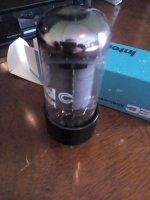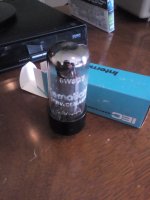I have an octal base 6 pin T9 bulb output tube. Similar to the 6V6 but the one unused pin on the 6V6 is absent on this tube. Tracing connections shows the same pin-out as a 6V6. Bakelite base has "Sylvania" with logo and USA. I looked around but didn't find anything. Thanks for any help.
Last edited:
The 6V6's I have in the little amp here at our holiday house, have 6 pins.
So if it looks like a 6V6, pins out like a 6V6, and has 6 pins like a 6V6, I would suspect it is a 6V6 .....
I don't have any 6F6 here to look at, but they could have 6 pins, and so could 6K6, and a lot of others ...
Win W5JAG
So if it looks like a 6V6, pins out like a 6V6, and has 6 pins like a 6V6, I would suspect it is a 6V6 .....
I don't have any 6F6 here to look at, but they could have 6 pins, and so could 6K6, and a lot of others ...
Win W5JAG
I assume it has a big "Power" plate; most octal pentodes have the same pinout so an RF/IF tube would pin the same but with smaller guts.
All the data I have found for 6V6 says 7-pin Octal.
Pin 1 is to bond the metal shell on metal 6V6 (rare but they exist). While all the 6V6G sheets show a pin 1 "NC", it would be logical for some tube maker to save the part-penny by omitting it on glass 6V6. As 6V6 were made by many factories (not always the ones they were branded and sold as), we can't know.
6V6 is improved 6F6 and 6K6 is real similar, so glass versions could also be made 7 or 6 pin. 6V6 is FAR more common today so that's my 2-cent bet.
All the data I have found for 6V6 says 7-pin Octal.
Pin 1 is to bond the metal shell on metal 6V6 (rare but they exist). While all the 6V6G sheets show a pin 1 "NC", it would be logical for some tube maker to save the part-penny by omitting it on glass 6V6. As 6V6 were made by many factories (not always the ones they were branded and sold as), we can't know.
6V6 is improved 6F6 and 6K6 is real similar, so glass versions could also be made 7 or 6 pin. 6V6 is FAR more common today so that's my 2-cent bet.
Pins 1 & 6 are not used. Now whether or not the manufacturer just decided not to put them on the finished product was probably a money saver or something like that. All my 6V6GT's have pins 1 & 6 omitted physically.
As above, also to possibly obviate sparking/leakage when said pin connectors are used as handy tie points for other components. This practice is presently used in most octal power tubes and rectifiers.
As asked, a picture please?
As asked, a picture please?
Pins 1 & 6 are not used.....
Yes, and the "7-pin Octal" specifically means pin 6 is supposed to be omitted.
RCA had a cunning plan to reduce mis-tubes. You could buy Octal sockets with missing holes. Rectifier might be a 4-hole Octal; I have seen these. Now you can't put the 6V6 in the rectifier socket. If the 6V6 socket was a 7-hole, then you could not physically put a full-8-pin tube in there (6SL7, maybe pentagrids).
The idea never caught on. The market moved to a limited set of high-volume parts, Octals with less than 8 holes never got common, radio makers bought sockets in bulk and didn't always know what they would make, so 8-hole was by far the most common.
Thanks for the confirmation that your 6V6es omit pin 1. That is what I recalled but I do not have any 6V6 within reach.
Pin 1 is to bond the metal shell on metal 6V6 (rare but they exist).
I have some metal 6V6. They have pin 1 and it's connected to the shell. Pin 6 is missing.
The most likely tube to confuse with a 6V6 would be a 6K6. Both have been made for a long time, and many variations exist.
I have seen both tubes with 6, 7 or 8 pins. The 6V6 SHOULD always have a beam former for G3 (tabs instead of grid rods in the top mica) and the 6K6 SHOULD always have 3 sets of grid rods. I'm sure that there are exceptions since rebranders don't always follow the rules. Most of the 6K6GT's that I have come with round plates, often with small wings, but I do have one example with a 6V6 plate in it. Every 6V6 that I have has an oval shaped plate, but that shape varies a lot. The 6W6 and 6Y6 have the same pinout. All the examples that I have use rectangular plates.
In many circuits the 6V6 and 6K6 can be interchanged. I used to do this in guitar amps for a slightly different "tone." The 6W6 and 6Y6 will fry quickly if plugged into a 6V6 socket.
also to possibly obviate sparking/leakage when said pin connectors are used as handy tie points for other components.
This was one of two lessons that I learned in an instant one day in high school electronics class. We had stuffed 4 each NOS metal 6L6's into an old pair of Stromberg Carlson PA amps because we had lots of them. I had put on the second Steppenwolf album and was unleashing about 200 watts of loud on the high school classroom when the record album touched one of the tubes. For reasons never understood our lab had grounded metal workbenches. The resulting shock sent the album cover flying Frisbee style across the lab. Lesson #1, pin 1 on one of the tubes had been used as a tie point for the red wire on the OPT. Lesson #2, the foil cover on the Steppenwolf album conducts electricity.
An emergency dragged me back to the office for a day.
I only keep a few caddies here, but I found glass 6K6, 6V6, and 6W6 with six pins.
I did not have any full base Sylvania 6V6 here; I do have some coin base Sylvania 6V6 ( marked RCA ) - seven pins.
No glass 6F6, some metal 1621 ( transmitting 6F6 ), and 6V6Y ( transmitting 6V6 ) - both types have seven pins.
I found glass 6K6 with six, seven, and eight pins.
All my glass 6V6 here are six or seven pins, excepting 5992 which has eight pins. 5992 does not have a bakelite base, so that excludes it, anyway.
I do have oval plate glass 6W6 BUT branded International, so who really knows what it really is. Marked Japan, the dimple on top suggests Matsushita made, that's a pretty big radiator fin compared to the other 6W6 here.
I have a 4 pin octal rectifier socket at home - it came out of a homebrew power supply I parted out. A lot of top hat diodes were in the supply, so I guess that dates it to early 60's?
Win W5JAG
I only keep a few caddies here, but I found glass 6K6, 6V6, and 6W6 with six pins.
I did not have any full base Sylvania 6V6 here; I do have some coin base Sylvania 6V6 ( marked RCA ) - seven pins.
No glass 6F6, some metal 1621 ( transmitting 6F6 ), and 6V6Y ( transmitting 6V6 ) - both types have seven pins.
I found glass 6K6 with six, seven, and eight pins.
All my glass 6V6 here are six or seven pins, excepting 5992 which has eight pins. 5992 does not have a bakelite base, so that excludes it, anyway.
I do have oval plate glass 6W6 BUT branded International, so who really knows what it really is. Marked Japan, the dimple on top suggests Matsushita made, that's a pretty big radiator fin compared to the other 6W6 here.
I have a 4 pin octal rectifier socket at home - it came out of a homebrew power supply I parted out. A lot of top hat diodes were in the supply, so I guess that dates it to early 60's?
Win W5JAG
Attachments
The tube is clealy a 6W6GT, the date code is faded?
http://www.mif.pg.gda.pl/homepages/frank/sheets/093/6/6W6GT.pdf
I think International IEC was made by Mullard.
The blue box dont say Mullard?
http://www.mif.pg.gda.pl/homepages/frank/sheets/093/6/6W6GT.pdf
I think International IEC was made by Mullard.
The blue box dont say Mullard?
Last edited:
Thanks for all the replies. The Holidays and other issues have been keeping me away. I don't have a photo service. The tube looks like a clear 6v6 with silvered top getter and the Bakelite base. Has a black rectangle (box) plate, not greyish like most tubes I see. It is out of a SE amplifier I bought for $10. Aside from a scratchy volume pot, it plays fine. Seems to be a 6v6 from what I gather.
I think International IEC was made by Mullard.
Many IEC tubes were made by Mullard, and that is often noted on the box. Some were made by US vendors, and some were Japanese.
The blue box dont say Mullard?
I have some blue IEC boxes containing 5AR4's that say "Japan."
Has a black rectangle (box) plate, not greyish like most tubes I see.......Seems to be a 6v6 from what I gather.
I have never seen a box plate 6V6. That doesn't make it impossible, but it could be a 6W6 or 6Y6. If you have a marked 6V6 try it in the amp. If the volume or power output drops, it wasn't a 6V6. Do not plug the mystery tube into a 6V6 amp. If it is a 6W6, it may blow up in a 6V6 amp.
If you have a way to measure the heater current, that is another clue. The 6V6 eats 450 mA, the others eat 1.2 amps. A DC power supply with a current meter is good enough.
.... never seen a box plate 6V6. That doesn't make it impossible, but it could be a 6W6 ovr 6Y6. ....
I don't recall seeing a box plate 6V6.
5824 ( I, think ), 50L6, 35L6, and the other series string variants of 6W6 are possible ..... We've been assuming this is a power transformer amp with 6 volt tubes, but that hasn't been made explicit.
Win W5JAG
- Status
- Not open for further replies.
- Home
- Amplifiers
- Tubes / Valves
- Help to identify output tube

